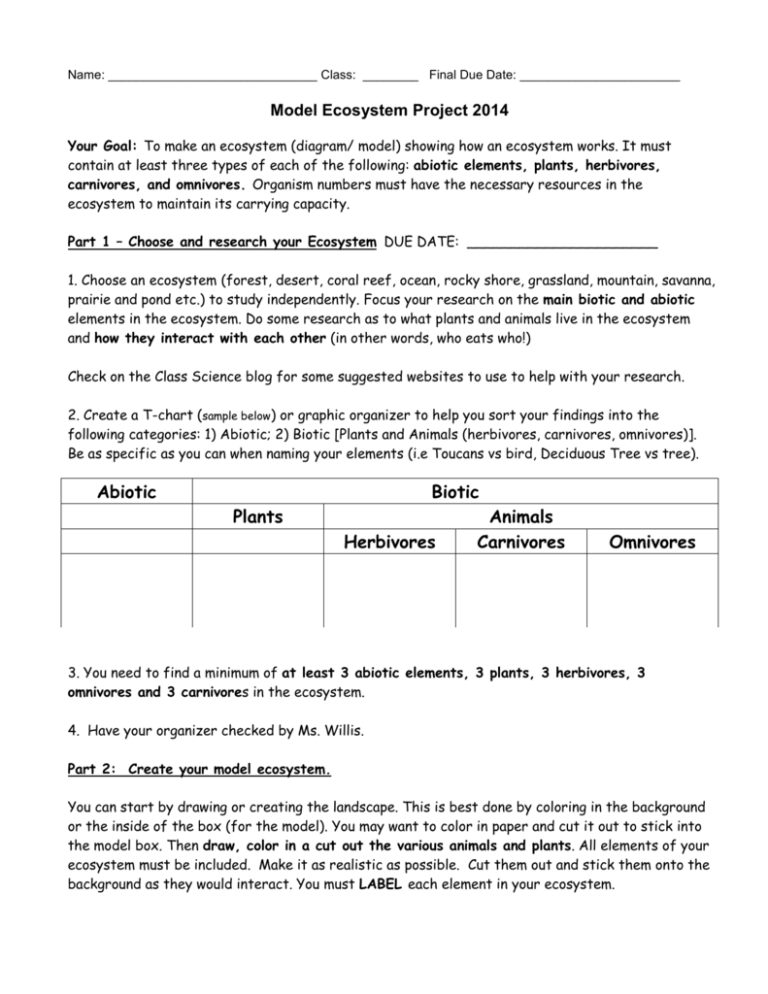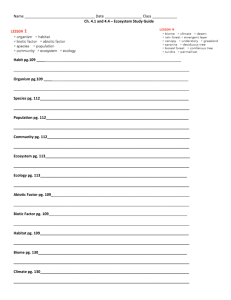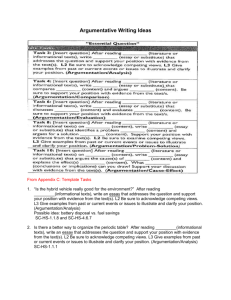Model Ecosystem Project 2014
advertisement

Name: ______________________________ Class: ________ Final Due Date: _______________________ Model Ecosystem Project 2014 Your Goal: To make an ecosystem (diagram/ model) showing how an ecosystem works. It must contain at least three types of each of the following: abiotic elements, plants, herbivores, carnivores, and omnivores. Organism numbers must have the necessary resources in the ecosystem to maintain its carrying capacity. Part 1 – Choose and research your Ecosystem DUE DATE: ______________________ 1. Choose an ecosystem (forest, desert, coral reef, ocean, rocky shore, grassland, mountain, savanna, prairie and pond etc.) to study independently. Focus your research on the main biotic and abiotic elements in the ecosystem. Do some research as to what plants and animals live in the ecosystem and how they interact with each other (in other words, who eats who!) Check on the Class Science blog for some suggested websites to use to help with your research. 2. Create a T-chart (sample below) or graphic organizer to help you sort your findings into the following categories: 1) Abiotic; 2) Biotic [Plants and Animals (herbivores, carnivores, omnivores)]. Be as specific as you can when naming your elements (i.e Toucans vs bird, Deciduous Tree vs tree). Abiotic Biotic Plants Herbivores Animals Carnivores Omnivores 3. You need to find a minimum of at least 3 abiotic elements, 3 plants, 3 herbivores, 3 omnivores and 3 carnivores in the ecosystem. 4. Have your organizer checked by Ms. Willis. Part 2: Create your model ecosystem. You can start by drawing or creating the landscape. This is best done by coloring in the background or the inside of the box (for the model). You may want to color in paper and cut it out to stick into the model box. Then draw, color in a cut out the various animals and plants. All elements of your ecosystem must be included. Make it as realistic as possible. Cut them out and stick them onto the background as they would interact. You must LABEL each element in your ecosystem. Part 3 – Interactions in the Ecosystem *FINAL DUE DATE: ____________________ Your Goal: Using the model ecosystem you have just created, you will generate one food chain/web. This will be submitted together with your model ecosystem at the end of this week. Throughout this unit, we have been examining how an organism interacts with the living and nonliving elements in an ecosystem. We have discussed and investigated predator/prey relationships as well as food chains and webs. Now it is time to put that knowledge into practice and explore some of the interactions between different components in your ecosystem apply it. 1. Using your model, show 1 food web that contains at least 8 elements. You must include a producer, a primary consumer, and a secondary consumer. They must be realistic feeding relationships! (*You may need to add an element to your ecosystem model – this is your time to make revisions to your model if necessary!). Remember, a food web contains many food chains; make sure your consumers have a variety of food to eat. 2. Only for the elements in your food web - add to their labels whether it is a producer or consumer. Each consumer must be labelled as a herbivore, carnivore, omnivore, or decomposer. 3. Begin constructing your food web. Draw all the connections within your web using an arrow between the elements to show there is interaction and pointing to where the energy is going. Write the type of interaction that is occurring on each line. On the diagram you could draw arrows to show the interactions. If you are doing the model you can hang some of the creatures from the roof of the box with fishing line. Example: breathe air deer The Conclusion: Your model ecosystem should include several biotic and abiotic elements and demonstrate the interactions between the biotic and abiotic elements (using arrows). Use the following checklist to help you develop a good project: □ Is your name on the front of the project? □ Is the ecosystem type identified? □ Is the model a 2D/3D representation of an ecosystem? □ Are all the elements included? (at least 3 abiotic, 3 plants, 3 herbivores, 3 omnivores and 3 carnivore) □ Are the elements correctly labelled? Each element must be labelled with its name. □ Are the food web elements correctly labelled? Each element must be labelled with its function. □ Are the relationships between the parts (if any) shown correctly? Are there connections within your web using an arrow between the elements to show there is interaction? You could be awarded with a bonus if your project is selected to be the Most Scientific, Most Attractive, or Most Disgusting. Students will vote to decide the winner in each category.








